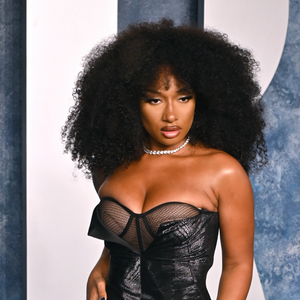The first CD I ever got as a present was Tori Amos's
Little Earthquakes. I had seen the video for
"Silent All These Years" on MTV and had put it
on my Christmas wish list only to have my 70-year-old
great-aunt deliver it -- all wrapped up in one of
those long cardboard CD boxes. I was 12 years old.
In the early '90s, when my generation was wallowing
in Claire Danes's self-esteem issues on My
So-called Life, other young girls
and gay boys like me found Tori Amos and immediately
knew we had found our voice. While some found
their identity in Nirvana and the passing of Kurt
Cobain, for me it was and always will be Tori.
I was lucky enough to be seated in the fourth row at the
Nokia Theater in Los Angeles on Sunday night, the last
night of her national tour. I had read
that Amos was taking turns performing as the various
doll characters that make up her conceptual new album
American Doll Posse. The idea: different songs
for different kinds of women, who presumably each represent
some aspect of her personality. Or, all women are made
up of similar archetypes like the rocker, the
vamp, etc. It doesn't really matter,
though, because the songs speak for themselves, and the
dolls serve as chapter headings.
She opened the show as the blond Isabel, vamping in a cloud
of smoke and puffing big clouds while slowly turning
and pulling the smoke over her head like she was
burning sage to clear the air. The first song up was
"Yo George," a not-so-thinly veiled message
to George W. Bush, then she
launched straight into "In the Springtime of His
Voodoo" from her controversial album Boys
for Pele. When she began to make stiff,
angular gestures with her arms -- at one point even
pausing to do the robot -- it took me a minute to realize
that she was pretending to be a doll. The first few
songs, as Isabel, were all performed as if she were in
a trance. For her performance of
"Scarlet's Walk" -- from the album of
the same name -- she even swung an antique
lamp back and forth methodically, trying to
hypnotize us.
A few songs in, Amos disappeared backstage only to emerge as
Pip, a sleek, sexy rock star with jet-black hair and
tight leather pants. The previously sedate and
definitely seated crowd rose to its feet for more
songs from American Doll Posse and even a cover
of Neil Young's "Heart of Gold." If her
previous character was an affectation, as Pip she was
possessed. Amos became Joan Jett, even Grace Jones.
Grabbing her crotch, sliding her hands all over her body,
and for some reason prostrating herself on the
ground -- half miming a doll trying to get up and half
humping the floor. At one point she even reminded the
writers on strike to stop sucking the "smegma off the
cock of corporate America." The sentiment was
ill-placed, particularly as she was performing in one
of the most sterile and certainly corporate venues
ever constructed. One need only walk into the lobby to see
the range of currently available Nokia phones on
display. But for songs like "Fat Slut"
and the now infamous 10-minute live version of
"Waitress," Pip was certainly
appropriate. Considering this second incarnation and the
songs she chose to accompany her character, I began to
understand more fully the vision Amos had for this
album. Then, after flicking the crowd off, she
disappeared again.
When she emerged, she seemed to be Teri, as she began with
"Big Wheel," which is attributed to Teri on the album
-- but perhaps she was herself. In either case, she
sported the red hair -- in a shade not found in
nature -- we have come to expect of Amos, and a sparkly gold
jump suit that we do not. This doll was happy to the point
of seeming stupid. Amos added a saccharine edge to her
voice and, as with the dolls before, seemed constantly
in character.
When the band left the stage for the requisite torch song
portion of the evening, it was just Amos and a
piano. This happened to be the best part of the show,
particularly "Bells for Her," which was
mesmerizing. The section ended with "Silent All
These Years," which seemed childish in the
doll voice but also raw, like it sounded when her
arrangements were simpler but no less powerful for it.
The evening came to a close with a synchronized rush of the
stage by much of the audience. It caught me by
surprise when several people, as if on cue,
flew past me to the aisles, where guards were for some
reason already waiting for them. And as Amos said
goodnight, there were tears in her eyes.
The show had it's problems. The costume
changes--carried off while her band jammed on some
riff of a song or, in one case, the dance version of
"Professional Widow"--were clumsy transitions, and I
imagine the show moved more smoothly when she remained
in one persona for the evening. Noticeably absent were
songs from her previous, unheralded album The
Beekeeper. But with its flowery imagery and mature
femininity, it wouldn't really fit into the show. If
her previous tour for Scarlett's Walk
could be described as folksy, this tour was sleek and
modern. Still, she had become the future Tori Amos and
had found a way to bring the old sound with her. She
also managed to bring the fans. When the songs were
up-tempo, they held their hands up and threw fists at the
stage; when it was time for "Bouncing Off
Clouds," they literally bounced up and down
like we had suddenly stepped into a Sublime concert.
Interestingly, the musical interludes were almost
psychedelic in their sound and lighting. A gathering
of groupies in the first couple of rows danced and
twirled their wrists like they were at a Jim Morrison
concert. They knew all the words to sections of songs that
had clearly been added on this tour alone. Had Tori
become the Grateful Dead? We were all quite a bit
older than the crowds I remember when I was 16, when I
saw her at a tiny theater at the University of Houston. At
28, I may have found my first musical transition
moment: I was suddenly a little too uncool for a
younger generation. But I also didn't care. If this
was where Tori was headed for the next tour, then I
was ready to paint my RV and hit the road.



















































































